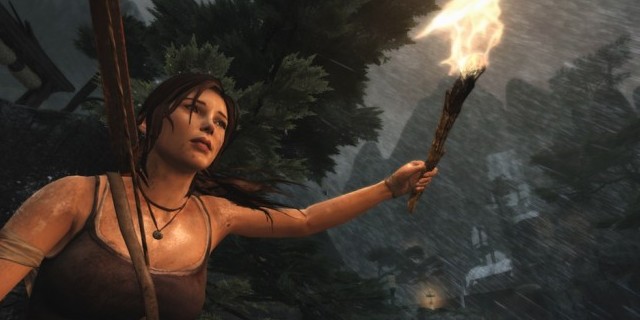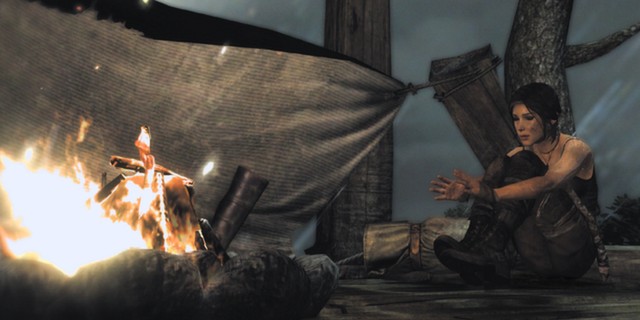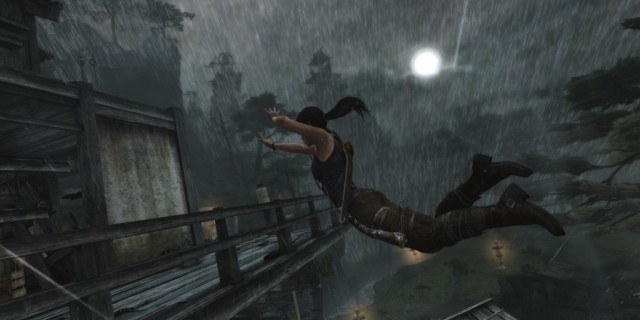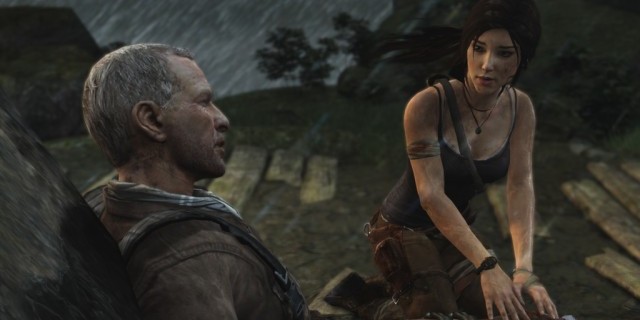
When discussing action franchises that defined a generation, you can’t forget to bring up Tomb Raider or its protagonist, Lara Croft. As one of the first major 3D action-adventure games to hit it big, Tomb Raider became a cultural phenomenon. However, after so many games in the venerable series, the popularity died down and the quality of each subsequent entry became less stellar. In short, the series needed a fresh take, and thus providing Crystal Dynamics a chance to start anew. Bringing us back to Lara’s very first adventure, Tomb Raider is a return to form for a series that desperately needed a new beginning.
Lara’s story begins with her aboard the Endurance, a ship on the way to investigate an island off the coast of Japan. On the way to their destination, a storm shipwrecks the crew on mysterious island. Lara, on her first major expedition, is lost and alone, needing to cope with what has happened while also learning to survive for the first time in her young life. The story heads in some rather predictable directions, but this isn’t about the mystery of the island: it’s about Lara herself.

She’s inexperienced yet still capable, and the story tracks her progress from naïve young explorer to full-fledged survivor. While some of her development feels slightly ham-fisted, the evolution of her character from start to finish is expertly handled. Early in the game, it is quite obvious that she has never experienced anything close to what is happened, yet is still skilled enough to just scrape by.
By the halfway point, you come to realize that she has finally had enough of everything happening to her. This leads to some incredible moments that define who she is and demonstrate her slow, but steady evolution into Lara Croft we all know and love. She’s never cocky, and doesn’t crack jokes, but begins to handle the situations with more confidence. It’s a new take on a character that feels like the start of something amazing.
The game’s basic structure takes you from place to place on the island, making sure you never stay in one spot for too long. There is plenty to explore, but you are limited in where you can go, at least in the beginning. Eventually you will gain the ability to fast-travel to different points on the island, and with a Metroid-style approach to the different areas (allowing you to return to old sections with new tools), you will have plenty of reason to explore.

There are plenty of collectibles to get, some that fill in the story of the different characters and the island itself, while others are merely trinkets left for the most collectible-obsessed to scavenge. The back tracking isn’t always rewarding, but the exploration quickly became a fun adventure all its own.
When you’re just exploring around the island, you’ll have plenty of opportunities to use your tools to discover new areas and collectibles. The tools you acquire, including an arrow that shoots ropes, allowing you to cross certain areas, all work in tandem with each other and when you acquire a new one, you’ll feel eager to go back and check out the sections of the island you now have access to.
While those expecting lots of tombs to be raided or even a big, open world to explore might be disappointed, there are plenty of reasons to go back to previous areas outside of the collectibles. There are a handful of optional tombs, each with its own unique environmental puzzles to solve. Once you, well, raid these tombs, you’ll be rewarded with plenty of salvage, which allows you to upgrade your different weapons. The tombs themselves are brilliantly designed and showcase some of the game’s more difficult puzzles, and the spoils of victory are always worth the effort.

The actual climbing, something you do a lot of throughout your adventure, is handled well, with precise controls that always feel capable. The story-based climbing sections clearly take inspiration from Uncharted, with plenty of things falling to pieces around you as you climb around certain areas. These moments are all scripted, but always make you feel like you’re just barely able to make it, with plenty of tense moments to keep your senses keen.
Tacky, tacked-on multiplayer
For the first time in the history of the series, Tomb Raider has a competitive multiplayer mode. If you read that and felt like hitting your head against your keyboard, you won’t be surprised to hear that it is entirely bland. While Tomb Raider’s combat is superb, it doesn’t translate well in a competitive setting, and the modes available are nothing to get excited about. It’s not bad, just entirely forgettable.
And when things slow down, you’ll encounter a decent number of puzzles, like the ones found in the optional tombs. They aren’t demanding, but are always a welcome addition as they give you a break from the action and require just the right amount of critical thinking. Don’t expect anything too complex, but they are enjoyable enough and allow for some fun experimentation with your different tools.
Then there’s the combat, which feels like one of the best examples of third-person shooting in a game in quite some time. At first you are armed with only a bow, which was my favorite weapon in the game. This allows you to take out enemies silently and requires a bit more finesse to use than your standard guns.
Some may never bother with it outside of particular parts of the game, but I found it to be the most rewarding weapon to use thanks to its precision and skillful aiming requirements. You’ll have to worry about leading your shots, making sure you have enough time to pull back the arrow while also maintaining your target in your sights. It’s not difficult, but it requires some patience, making those headshots even more gratifying than ever.

The other weapons are perfectly fine as well, including your standard pistol, machine gun and shotgun. Each weapon has its advantages and disadvantages, making your use of each one during specific moments crucial. If enemies get close, you have a melee attack, allowing you to knock them away or deliver a finishing blow if possible, which is always handy during the more intense firefights. And the cover system is dynamic and allows you to move more easily from point to point, never forcing you to “stick” to any particular piece of cover.
This is also where quick-time events are thrown in, which work sometimes, allowing you to execute the perfect finishing blows. But other times (especially during cutscenes), they feel poorly handled and can bring the action to a grinding halt. Sometimes you’ll have to repeat an entire sequence because of one mistimed button press, which in this day and age feels archaic.
At many points in the game, you’ll come across camps which allow you to upgrade your weapons and fast travel, as mentioned above, but also unlock new skills. You earn experience as you complete story objectives, kill enemies, and find collectibles in the environment, among other things. Some of the ways you earn XP are introduced in the story, such as gathering plants or hunting animals, but they feel tacked on and unnecessary in the grand scheme of things. Having Lara hunt for food seemed like a cool idea, but outside of the beginning of the game you never have much of a reason to do so.
Graphically speaking, Tomb Raider is impressive, even on now-dated console hardware. The attention to detail is astounding, and each new environment on the island is a showcase for just how much work was put into making the game look as amazing as possible. There are the occasional framerate hiccups and bad textures, but nothing that will tarnish an otherwise superb visual experience.
It may not satisfy all Tomb Raider fans, but Lara Croft’s return is an excellent one, complete with a new take on the character that feels essential. Crystal Dynamics was able to breathe new life into the series and the character with fantastic results, thus giving me hope for a franchise I once considered one of the greats. Developers and publishers, pay attention; this is how you reboot a franchise.
Pros: Satisfying controls and gunplay, plenty to explore, Excellent character development
Cons: Some annoying quick-time events, forgettable multiplayer



















